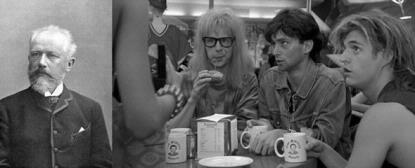
The literature on the philosophy of music consists, by and large, of works that promote one of the two rather antithetical ideologies. First, there are the musical formalists who believe that the true target of our artistic admiration is the purely structural nature of the musical work, described as the arbiter of “tonally moving forms” by Edward Hanslick, perhaps the most notable of the proponents of this position. Considerations external to the notation and the sounds produced therefrom, such as emotional responses or associations forged between the music and people, places, or ideas of which one is said to be reminded by it, are to be eschewed in favor of an appreciation of its inherent “architecture.” (George Birkhoff’s Aesthetic Measure is an interesting read, as, in this book, the author presents an exhaustive defense of an equation that is used to precisely calculate this “aesthetic measure,” a figure that he candidly admits is based on structural matters only at the expense of the complete detachment from emotional or spiritual considerations.)
Second, there are those that might be described as “emotivists” or “subjectivists;” namely, those that use their emotional responses to the music as well as the associations forged between it and entities that it is supposed to remind them of, or that they are alleged to signify or represent, as a factor in their determination of its value or significance. These are the people who advise themselves and others to “feel the music.” In addition to positing an inherent power of the music to elicit emotional responses, they also frequently advocate the consideration of the historical, societal, political, and even philosophical context in which a particular piece was composed as concepts to better inform their own appreciation and understanding of the work, even maintaining in some cases that these considerations are the catalysts for the emotional response to music that they have as they put themselves into the time and place of the composer while listening to it.
When it comes to music in the motion picture, both sides seem to face an obstacle that may seem rather damaging to their positions. First, the formalist must acknowledge that the accompaniment to a particular scene is music that was deliberately composed in the appropriate emotional “tone.” The music of the film serves as a buffer of sorts to the various vicissitudes of the characters, and no degree of formalist inclination can deny that purpose to the music.
However, the emotivist is in the peculiar predicament of trying to reconcile the associations that he is forming with the music with those that the director, writer, and composer of the film have demonstrated. (He is, after all, himself, and not Luke Skywalker.) He might feel that the music “means” less to him if the interpretations are conflicting, and much less in the case when music that he might otherwise fondly enjoy is being used for a tawdry or downright ridiculous scene. Consider, for instance, the powerfully emotional and dramatic music that accompanies Harry and Lloyd’s embrace in the “Aspen it is” scene from Dumb and Dumber, or the use of Tchaikovsky’s Romeo and Juliet Fantasy Overture to accompany Garth’s enraptured gaze upon the woman at the donut shop in Wayne’s World.
Thus, it appears that, however vital the contribution of the music is to the motion picture, the best method of evaluating it in a way that preserves the integrity of the aforementioned positions is to approach it as “absolute” music, separate from the context of the film itself. This, of course, should not be considered an inappropriate, and certainly not an unprecedented, approach.
Consider, for instance, the production and release of the soundtracks to the films on CDs in addition to and separate from the production and release of the entire film, or the performances by major orchestras of the scores to Harry Potter or The Lord of the Rings without the film being shown on a screen above the stage. The identity of film music as film music thus seems to be jeopardized in these circumstances, it needing to be considered purely as absolute music in order to maintain fidelity to the positions adopted by both formalists and emotivists. Would it not be more appropriate to call such music “music for the film,” rather than “film music?” The minor change in its description carries rather significant implications from the standpoint of musical identity.


